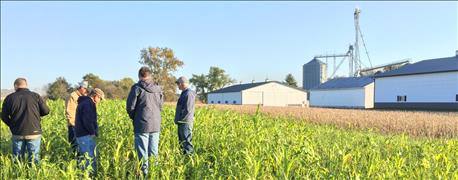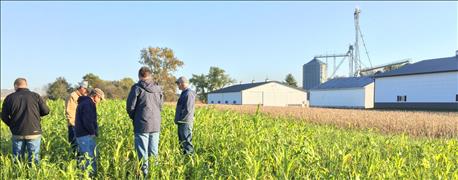
You have a cover crop growing in the field. Did you pay attention to it during the fall? Did you actually walk and scout the field to see what’s happening? Are you making plans to scout it regularly this spring once it begins growing again?
Clint Harrison says if you are serious about cover crops, there are several things you can learn by scouting them while they are growing, both in the fall and the spring. Harrison is a district conservationist with the Natural Resources Conservation Service.
The information provided here comes from the Indiana Conservation Partnership. Various NRCS personnel and other partnership members contributed.

SCOUT AND SCOUT MORE: This group of people gathered to discuss managing cover crops in late fall. Clint Harrison with NRCS says it’s important to scout cover crops in the spring, too. (Photo courtesy of Kris Vance, NRCS)
If you planted cover crops, you likely did so for a specific purpose, Harrison says. Regardless of the reason you planted them, you will learn valuable lessons by scouting throughout their growth to see if they are doing what you hope, and to decide if you should do things a little differently next year, he adds. Here are five things to look for at various times of the year:
1. Nodules on legumes. If you planted legumes like clover, hairy vetch or field peas, you likely are hoping to get some nitrogen for your upcoming corn crop, Harrison says. If you're not seeing many nodules, the crop may need to grow longer. That may mean planting earlier or terminating later, or it may mean adding the appropriate rhizobium bacteria.
2. Beneficial insects. Do you see any ground beetles, green lacewings or lady beetles? These critters eat aphids, slugs, black cutworm moths, armyworms and other pests. If you see these pests at economic threshold levels, you may need to treat them using other methods in your Integrated Pest Management strategy. If you do, try to minimize harm to the beneficial insects. If you don’t see these beneficial insects, be sure to use pesticides and seed treatments only when needed, and in a way that minimizes impacts to these insects. Also. continue to provide a diverse habitat with crop rotations and cover crops without disturbing the soil.
3. Worms. Do you see earthworms, middens or holes when you dig? These are nature’s soil cyclers, and they'll readily convert your crop residues and other plant materials into beneficial soil organic matter, Harrison notes. If you don’t see many, continue to provide a diverse habitat with crop rotations, include cover crops such as brassicas that earthworms love, and don’t disturb the soil.
4. Roots. Using a spade, Harrison suggests testing a few samples of soil. Take note of the depth of the roots. How is the soil tilth? Are the roots reducing your compacted layers? Has the cover crop helped prepare the soil for planting? If the answers are no, continue with your cover crops, try to include different species, and don’t disturb the soil.
5. Winter annuals. Has the cover crop helped suppress the growth of winter annuals? Or will you need a plan to control these prior to planting?
About the Author(s)
You May Also Like




